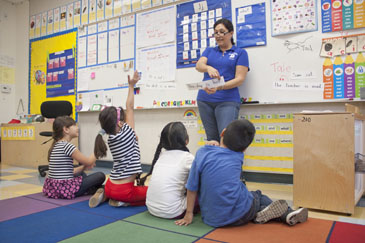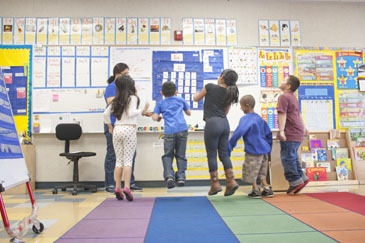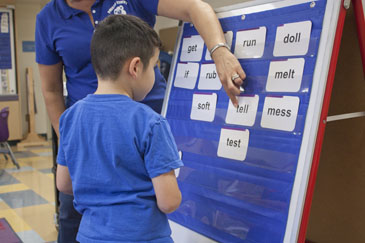
The "Truth or Tale" Game
Learn sentences by matching what they hear and what they read.
Tutorial classes and special attention to students may seem like an impossible luxury to working-class families, intervention coordinators are here to bridge that gap.

Learn sentences by matching what they hear and what they read.

Familiarizing students with the "j" sound with motion.

Matching first letter sounds to help students with pronunciation.

Matching first letter sounds with pictures to learn pronunciation.

Reading along helps students blend letter sounds in sentences.
 Kimberly, Michelle, Giselle, Guadalupe, Joshua and Allisson participate actively in Mrs. Valdez's intervention sessions.
Kimberly, Michelle, Giselle, Guadalupe, Joshua and Allisson participate actively in Mrs. Valdez's intervention sessions.
Tutorial classes and special attention to students may seem like an impossible luxury to working-class families, intervention coordinators are here to bridge that gap.

After a long day of work, working-class mother Susanna Barraza came home to ask her daughter, Kimberly, what she had learnt in class at the Fourth Street Primary Centre. Kimberly replied despondently with “I don’t know”s or “I didn’t want to do it in class.” Barraza had been spending hours on top of her packed daily schedule to help Kimberly but she didn’t seem to know how or have the right tools to reinforce Kimberly’s education at home.
Kimberly is one of the 10 to 15 percent of students in a normal classroom setting who are “at-risk” students - kids who are struggling to reach their grade level. This is the grey area between students who need one-to-one attention with possibilities of learning disabilities (Tier 3) and students who are able to follow in class (Tier 1). The difference, however, with “at-risk” students in a high-income family and a low-income family lies in the reinforcement at home.
“Classes begin and end, begin and end. There’s no time for mistakes and Kimberly isn’t a quick learner,” said her mother. “As a parent, you just don’t understand why your kid isn’t learning.” Today, Kimberly comes home smiling with confidence, telling her mother about the games she has played in class and the words that she’s been learning.
The reason behind this change is a new teaching position at school - Intervention Coordinator Terry Valdez. Her position is part of a program called “Response to Intervention”, which identifies the reasons students are falling behind and helps them with tailored games and exercises.
“You have to understand why the child is performing low and do everything before she reaches tier 3,” said Valdez. She works in a small-group setting, helping three to six first-graders each session (see Soundslides).
 Kimberly, Ulises, Rosemary, Drew and Joshua jump in a game to recgonize letter sounds.
Kimberly, Ulises, Rosemary, Drew and Joshua jump in a game to recgonize letter sounds.

“We have the struggle of making ends meet and having the basic things,” said Valdez. “And I went through that. My purpose here is to help students reach the same dreams and goals as I did.” Valdez grew up in a single-parent family with her mother working six days a week. “She instilled the idea that doing my homework would make me a very important someone in the future and that made me responsible for my own learning.”
Other than helping students, Valdez also holds monthly parent conferences to show them how to reinforce their child’s learning at home in their daily lives. Instead of feeling lost with helping Kimberly at home, Barraza now learns tips for learning and teaching at home from Valdez. “She went out of her way to get me big vowel cards and taught me how to play bingo or cut out magazine words," said Barraza. "Kimberly is playing and learning, I can see the progress.”
“Some parents just don’t know how but they mean well,” said Valdez. “I see myself as a resource to help them and when I teach them the way, I get a lot of ‘I never thought about doing that!’” However, there are parents who have told Valdez that they simply don’t have time outside their work or that their language barrier or social issues may get in the way.
A UCLA study also shows that high-income parents spend on average three hours more weekly talking to their school-aged children than low-income parents, and an additional four and a half hour more for out-of-classroom activities such as going to parks and churches for their toddlers. “Sometimes having food on the table is more important but they don’t understand education is the key to everything, to a better life,” said Valdez.
“That’s the whole purpose of it,” said Principal Lupe Carrandi of Fourth Street Primary Center, referring to the program. “To bridge that gap and provide more services for the kids.”
Source: Estimated Participation and Hours in Early Care and Education by Type of Arrangement and Income at Ages 2 to 4 in 2010The program, however, is at risk of losing its funding from the district due to decreasing enrollment - there may not be an intervention coordinator available to students next year. “Our funding is really based on our enrollment and the economic level of students. We lose enrollment from families moving out or going to charter schools, we lose teaching positions,” said Carrandi. “The parents really like the program, having a person out of classroom.”
“We try to give these kids an opportunity to strive, and education is one of those tools,” said Valdez. “That’s what I want to do because it could get better."
